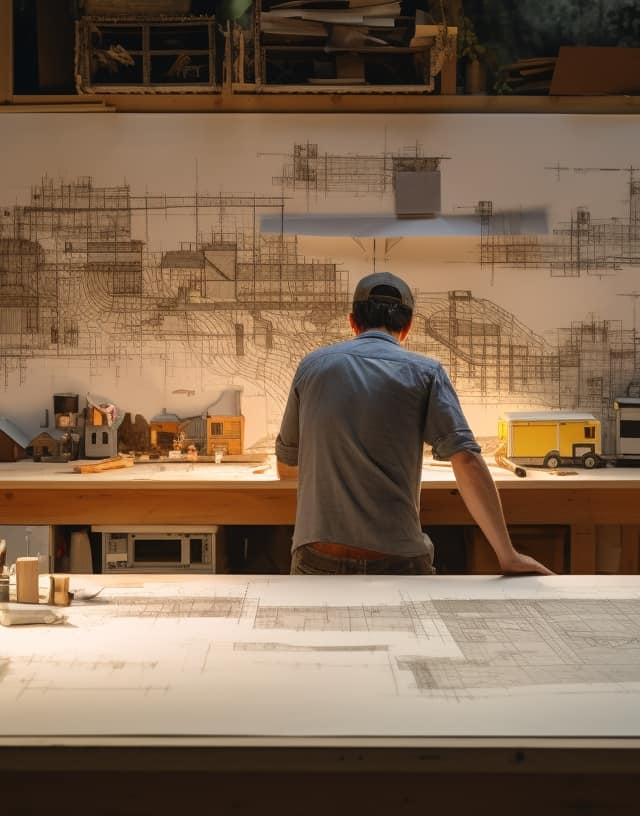We have started on a mission to discover the essential steps in constructing a tiny house.
From selecting the perfect plan to sourcing materials and preparing the foundation, each task plays a vital role in creating a cozy and functional home.
With our guide, you will learn how to construct the frame, install utilities, and apply the finishing touches both inside and out.
Join us as we explore the ins and outs of this rewarding and fulfilling building process.

Key Takeaways
- Planning and design are crucial steps in building a tiny house, including determining the size and layout, creating a detailed blueprint, and considering factors like accessibility and sustainability.
- Foundation and framing are important for creating a sturdy base for the tiny house, including choosing a suitable foundation type, calculating weight-bearing capacity, and installing insulation for energy efficiency.
- Electrical and plumbing systems need to be carefully designed and installed, including considering power needs, installing wiring and outlets, and planning for water supply and waste management.
- Interior finishes and features play a significant role in maximizing space and comfort, including choosing durable materials, installing efficient heating and cooling systems, and incorporating multi-functional furniture.
Choosing a Tiny House Plan
Now let’s talk about the next step in building our tiny house: choosing a tiny house plan.
The design of our tiny house is crucial as it determines the layout, functionality, and overall appeal of our future home. When selecting a tiny house plan, it’s important to consider our specific needs and preferences.
We should think about the number of rooms, storage space, and any unique features we desire. Additionally, budgeting considerations play a significant role in this decision. We must ensure that the chosen plan aligns with our financial resources, as certain designs may require more expensive materials or complex construction techniques.
By carefully evaluating various tiny house designs and considering our budget, we can make an informed decision that satisfies both our practical and aesthetic requirements.

Now that we’ve chosen our tiny house plan, the next step is sourcing the materials we’ll need.
Sourcing Materials
To build our tiny house, we’ll need to source the materials and gather all the necessary supplies. Sourcing materials is a crucial step in the construction timeline, as it ensures that we’ve everything we need to bring our vision to life.
We can start by creating a detailed list of all the materials required, such as lumber, insulation, roofing, windows, and doors. Once we’ve our list, we can begin researching suppliers and comparing prices to find the best deals. It’s important to consider both the cost and quality of the materials to ensure that our tiny house is built to last.
Foundation Preparation
When it comes to foundation preparation for a tiny house, there are three crucial points to consider.

Firstly, soil testing and excavation are essential to ensure the stability and strength of the foundation.
Secondly, choosing the right materials, such as concrete or gravel, is crucial for a solid and durable foundation.
Lastly, ensuring proper drainage is vital to prevent water accumulation and potential damage to the foundation.
Soil Testing and Excavation
We always start by conducting soil testing and excavation to prepare the foundation for our tiny house. Soil testing methods are crucial in determining the composition and stability of the soil. This information helps us design a suitable foundation that can support the weight of the structure. We use various techniques such as taking soil samples and conducting laboratory tests to analyze the soil’s characteristics, including its moisture content, density, and load-bearing capacity.

Excavation techniques are then employed to remove any unsuitable soil and create a level surface for the foundation. This involves using heavy machinery, such as excavators, to dig the required depth and width for the foundation. Excavation also allows for the installation of underground utilities, such as plumbing and electrical lines, before the foundation is constructed.
Choosing the Right Materials
Our first step in foundation preparation is selecting the right materials for our tiny house. When choosing the materials, it’s important to consider both sustainability and cost. Here are some key considerations:
-
Sustainable options:
-
Recycled materials: Using reclaimed wood or recycled steel can reduce the environmental impact of our tiny house.

-
Eco-friendly insulation: Opting for insulation made from natural materials, like cellulose or sheep’s wool, can improve energy efficiency while minimizing harm to the environment.
-
Cost considerations:
-
Budget-friendly materials: Selecting affordable options like plywood or concrete blocks can help keep the overall cost of our tiny house down.
-
Long-term durability: Investing in high-quality materials might have a higher upfront cost but can save money in the long run by reducing maintenance and replacement expenses.

Ensuring Proper Drainage
One crucial step in building a tiny house is ensuring proper drainage for our foundation preparation. Proper grading and effective drainage are essential to prevent water damage and maintain the stability of the house. To achieve this, we need to carefully plan and execute the following steps:
| Steps | Description |
|---|---|
| Evaluate the site | Assess the topography and soil composition to determine the best location and identify potential drainage issues. |
| Grade the land | Level the ground and create slopes away from the foundation to direct water flow away from the house. |
| Install drainage systems | Install French drains, gutters, and downspouts to collect and redirect water away from the foundation. |
| Use permeable materials | Choose permeable surfaces, such as gravel or porous pavers, to promote water absorption and reduce runoff. |
| Maintain the drainage system | Regularly inspect and clean the drainage system to ensure it remains functional and free from obstructions. |
Frame Building
When it comes to frame building for a tiny house, there are several crucial steps to follow. Building techniques and structural design play a significant role in ensuring the stability and durability of the structure.
Here are the key steps involved in frame building:
-
Planning and Design

-
Determine the size and layout of the tiny house.
-
Create a detailed blueprint of the frame structure.
-
Foundation and Floor Framing
-
Prepare the foundation, whether it’s a trailer or a permanent base.

-
Install the floor joists and secure them properly.
-
Wall and Roof Framing
-
Construct the walls using appropriate building techniques.
-
Install roof trusses or rafters and sheathing.

Installing Utilities
Now, let’s talk about the crucial step of installing utilities in your tiny house.
This includes setting up the water and sewage systems, as well as making the necessary electrical connections.
Ensuring a reliable water supply and proper waste disposal is essential for a comfortable living space, while electrical connections are needed to power your appliances and lighting.
Let’s take a closer look at each of these points to understand the process better.

Water and Sewage
Our first step in installing utilities for our tiny house is to determine the best location for our water and sewage systems. This involves considering factors such as accessibility, convenience, and sustainability.
To ensure clean and safe water, we’ll install a water filtration system that removes impurities and contaminants. This will provide us with a reliable source of drinking water.
For our sewage system, we’ve decided to use a composting toilet. This eco-friendly option converts human waste into nutrient-rich compost, which can be used as fertilizer for plants. It’s a cost-effective and sustainable solution that eliminates the need for traditional plumbing.
By carefully planning the location of our water and sewage systems and incorporating efficient and environmentally friendly technologies, we can create a functional and sustainable living space.

Now that our water and sewage systems are in place, we can move on to the next crucial step: electrical connections.
Electrical Connections
To ensure a reliable power supply, we will connect our tiny house to the electrical grid and install solar panels for renewable energy generation. This will not only provide us with a backup power source but also help us reduce our carbon footprint. However, it is crucial to prioritize electrical safety during the installation process. We will hire a licensed electrician to handle the electrical connections and ensure that all the wiring is up to code. Additionally, we will install a circuit breaker panel to protect our tiny house from electrical overloads. The solar panels will be strategically placed to maximize sun exposure and generate sufficient power. By combining the electrical grid and solar power, we can enjoy a steady supply of electricity while being environmentally conscious.
| Electrical Safety | Solar Power |
|---|---|
| Hire a licensed electrician | Install solar panels strategically |
| Ensure wiring is up to code | Maximize sun exposure |
| Install a circuit breaker panel | Generate sufficient power |
Interior Finishing
After completing the construction of our tiny house, we’ll move on to the exciting stage of interior finishing. This is where we get to put our personal touch on the space and make it feel like home.
When it comes to interior design, we want to create a space that’s both functional and aesthetically pleasing. Here are a couple of key steps to consider:

-
Choosing the right materials: We want to select materials that are durable, easy to clean, and visually appealing. This includes things like flooring, countertops, and cabinetry.
-
Optimizing space: In a tiny house, every square inch counts. We’ll need to carefully plan the layout to maximize storage and make the most of the available space. This could involve using multi-functional furniture, built-in storage solutions, and clever organization techniques.
Exterior Finishing
We frequently prioritize the exterior finishing of our tiny house to ensure it isn’t only visually appealing but also weather-resistant and durable.
The exterior design of a tiny house plays a crucial role in creating a welcoming and aesthetically pleasing look. It’s important to choose materials that aren’t only durable but also resistant to the elements.

Weatherproofing techniques, such as proper insulation and sealing, help protect the tiny house from moisture, wind, and other environmental factors. Additionally, choosing the right exterior paint or siding can enhance the longevity of the house by preventing water damage and protecting against UV rays.
Investing in high-quality materials and utilizing effective weatherproofing techniques will ensure that the exterior of our tiny house not only looks great but also stands the test of time.
Common Questions and Issues During Construction
Some of the most common questions and issues that arise during construction are how many electrical outlets are needed and where they should be placed, as well as how to properly insulate the walls to ensure energy efficiency. These challenges can be addressed by considering cost and functionality.
Here are some common challenges and cost considerations to keep in mind during the construction process:

-
Electrical outlets:
-
Determine the number of outlets based on your power needs and the layout of your tiny house.
-
Place outlets strategically throughout the house to ensure easy access and convenience.
-
Insulation:

-
Choose the right insulation materials that provide maximum energy efficiency.
-
Properly insulate the walls, floors, and roof to prevent heat loss and maintain a comfortable living environment.
Long-Form Response: The Complete Tiny House Building Process
By carefully following each step in the building process, we can create our own custom-designed and fully functional tiny house.
Building a tiny house has its pros and cons. On the positive side, it offers financial freedom, environmental sustainability, and the ability to live a clutter-free lifestyle. However, it also requires careful planning, limited space, and potential zoning restrictions.

To maximize space in a tiny house, there are a few tips to keep in mind. Utilizing multifunctional furniture, such as a sofa that can transform into a bed, is essential. Additionally, incorporating storage solutions, like built-in cabinets and shelves, can help keep things organized. Using vertical space efficiently by installing loft beds or overhead storage is another effective strategy.
With proper planning and creative thinking, a tiny house can offer comfort and functionality despite its small size.
Frequently Asked Questions
What Are the Legal Requirements for Building a Tiny House in My Area?
Legal considerations and zoning regulations are important when building a tiny house in our area. We need to research the specific requirements, permits, and restrictions set by local authorities to ensure compliance and a smooth building process.
How Much Does It Typically Cost to Build a Tiny House?
When building a tiny house, it’s crucial to consider the cost. Our budgeting strategies help determine the expenses involved, ensuring we stay within our means and achieve our goal of creating an affordable and sustainable living space.

Can I Build a Tiny House on Wheels or Does It Have to Be on a Foundation?
Building a tiny house on wheels offers flexibility and mobility, while a foundation provides stability and permanence. Consider pros and cons of each option. To make a tiny house on wheels more stable and secure, use proper anchoring and reinforcement techniques.
Are There Any Restrictions on the Size or Height of a Tiny House?
There are some restrictions on the size and height of a tiny house. These limitations vary depending on local building codes and zoning regulations. It’s crucial to research and comply with these guidelines when planning your tiny house project.
How Long Does It Usually Take to Build a Tiny House From Start to Finish?
Building a tiny house typically takes several months, depending on factors such as complexity and available resources. Throughout the process, we face challenges like sourcing materials and coordinating different tradespeople, but seeing the final result is incredibly rewarding.
Conclusion
In conclusion, building a tiny house involves several crucial steps. These steps include choosing a plan and sourcing materials, preparing the foundation, building the frame, and installing utilities. Additionally, interior and exterior finishing touches are important to consider. Throughout the construction process, common questions and issues may arise. However, with careful planning and attention to detail, the end result can be a beautiful and functional tiny home.

For example, imagine a couple who built their dream tiny house on wheels. This allows them the freedom to travel and explore new places while still having a comfortable and cozy home to return to.
I’m Theodore, and I love tiny houses. In fact, I’m the author of Tiny House 43, a book about tiny houses that are also tree houses. I think they’re magical places where imaginations can run wild and adventures are just waiting to happen.
While tree houses are often associated with childhood, they can be the perfect adult retreat. They offer a cozy space to relax and unwind, surrounded by nature. And since they’re typically built on stilts or raised platforms, they offer stunning views that traditional homes simply can’t match.
If you’re looking for a unique and romantic getaway, a tree house tiny house might just be the perfect option.










